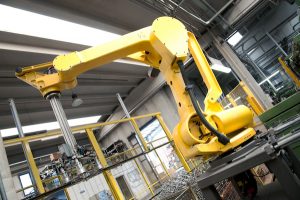Whether you are in the business of assembly operation or a fulfillment house, automating the distribution of broad and varied mix of parts or SKU’s is no longer a challenge. 3D vision robotics is changing the face of bin-picking. It will improve both the accuracy and speed when it comes to sorting and identifying any mix of inventory presented in bins, totes, cases or cartons.
In any bin-picking application, each item must be sorted and removed from the bin or tote that is full of similar or varying items, then placed into individual containers for packaging fulfillment, or moved onto additional manufacturing processes. The job is repetitive, but fast paced. However, it requires a high level of accuracy and consistency – both of which are characteristics that make it an ideal candidate for automation.
Human workers can look into the jumbled bin full of parts and pieces and immediately identify the best way to pick up individual items based on their shape and position and avoiding the edge of the bin with ease as they reach inside. The complexities of automating these actions have been prohibitive – that is, until recently.
At the minimum, bin-picking applications require the system to work with a 3D camera, vision software, and a robotic arm with appropriate gripper. With all of that technology on board, there continued to be challenges. To date, it’s been the vision software that has lacked the sophistication and accuracy to really speed automation in a factory setting.
Even with new robot and camera technologies, visions system challenges exist at every step. The robot arm must provide full 6-axis movement in order to use varying approach vectors to reach into the bin without hitting the box sides and then pick up items that can be lying on top of each other in a wide range of positions and orientations. The camera must be able to scan, process, and communicate data quick enough to coordinate the robot’s actions. And the images captured must be clear enough to show more than just outlines of the items in the bin. For the robot gripper to effectively approach a targeted item, the position and orientation of items that may be jumbled or overlapping must also be identified.
However, there is new vision system technology on the market. When you choose our CCTV precision lens assemblies, you can rest-assured you are making the right choice for your bin-picking application. The new technology eliminates stumbling blocks with easy programming of the bin-picking robotic arms. With the use of two integrated, high-speed stereo cameras, pickers are now capable of 30 frames per second for continuous, real-time 3D images.
Many of the new designs are easy to install and come fitted with intuitive multi-touch controls, which keeps the robotic arms from bumping into the sides of the bins. Integrated embedded PCs ensure short scanning and computing times during operation. The CAD-based teach-in function allows you to teach new components in just a few clicks, offering an almost unlimited range of detectable components.